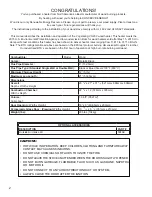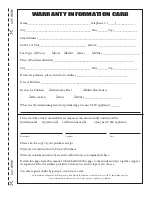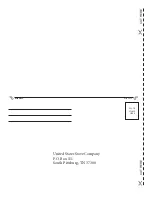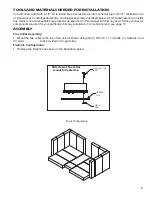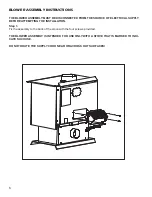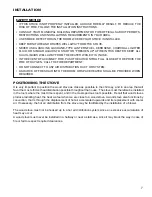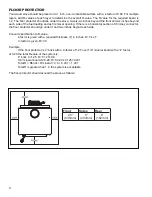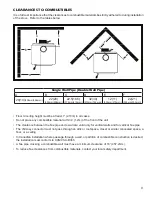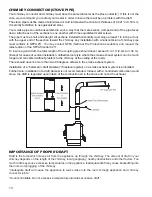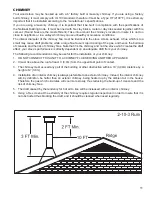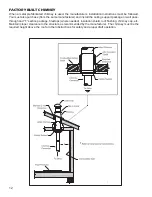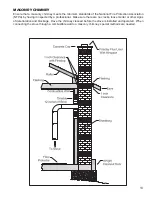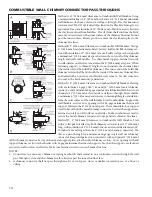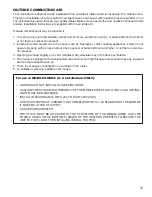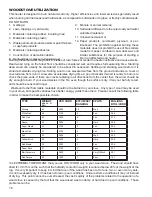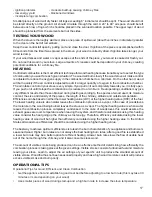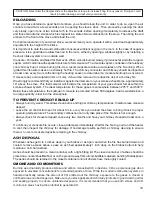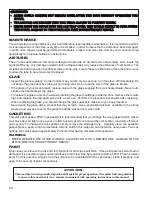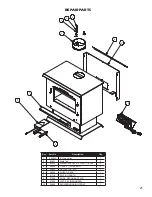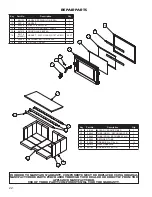
16
TYPE
WEIGHT
(LBS. CU. FT.,
DRY)
PER CORD
EFFICIENCY
RANKING
SPLITS
MILLIONS
BTU’s/CORD
Hickory
63
4500
1.0
Well
31.5
White Oak
48
4100
.9
Fair
28.6
Red Oak
46
3900
.8
Fair
27.4
Beech
45
3800
.7
Hard
26.8
Sugar Maple
44
3700
.6
Fair
26.2
Black Oak
43
3700
.6
Fair
25.6
Ash
42
3600
.5
Well
25.0
Yellow Birch
40
3400
.4
Hard
23.8
Red Maple
38
3200
.3
Fair
22.6
Paper Birch
37
3100
.3
Easy
22.1
Elm/Sycamore
34
2900
.2
Very Dif
fi
cult
20.1
Red Spruce
29
1800
.1
Easy
16.1
WOODSTOVE UTILIZATION
This heater is designed to burn natural wood only. Higher ef
fi
ciencies and lower emissions generally result
when burning air dried seasoned hardwoods, as compared to softwoods or to green or freshly cut hardwoods.
DO NOT BURN:
It is EXTREMELY IMPORTANT that you use DRY WOOD only in your wood stove. The wood should have
dried for 9 to 15 months, such that the humidity content (in weight) is reduced below 20% of the weight of the
log. It is very important to keep in mind that even if the wood has been cut for one, two or even more years,
it is not necessarily dry, if it has been stored in poor conditions. Under extreme conditions it may rot instead
of drying. This point cannot be over stressed; the vast majority of the problems related to the operation of a
wood stove is caused by the fact that the wood used was too damp or had dried in poor conditions. These
problems can be:
1. Garbage;
2. Lawn clippings or yard waste;
3. Materials containing rubber, including tires;
4. Materials containing plastic;
5. Waste petroleum products, paints or paint thinners,
or asphalt products;
6. Materials containing asbestos;
7. Construction or demolition debris;
8. Railroad ties or pressure-treated wood;
9. Manure or animal remains;
10. Salt water driftwood or other previously salt water
saturated materials;
11. Unseasoned wood; or
12. Paper products, cardboard, plywood, or par-
ticleboard. The prohibition against burning these
materials does not prohibit the use of
fi
re starters
made from paper, cardboard, saw dust, wax and
similar substances for the purpose of starting a
fi
re in an affected wood heater.
Burning these materials may result in release of toxic fumes or render the heater ineffective and cause smoke.
Dead wood lying on the forest
fl
oor should be considered wet, and requires full seasoning time. Standing
dead wood can usually be considered to be about 2/3 seasoned. Splitting and stacking wood before it is
stored accelerates drying time. Storing wood on an elevated surface from the ground and under a cover or
covered area from rain or snow also accelerates drying time. A good indicator if wood is ready to burn is to
check the piece ends. If there are cracks radiating in all directions from the center then the wood should be
dry enough to burn. If your wood sizzles in the
fi
re, even though the surface is dry, it may not be fully cured,
and should be seasoned longer
Waste and other
fl
ammable materials should not be burned in your stove. Any type of wood may be used
in your stove, but speci
fi
c varieties have better energy yields than others. Please consult the following table
in order to make the best possible choice.
Summary of Contents for VG200
Page 23: ...23 Notes ...

